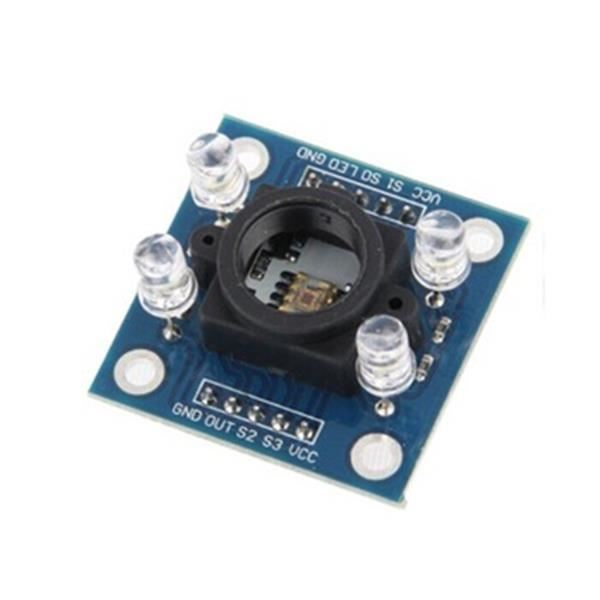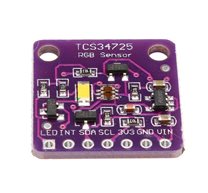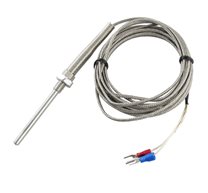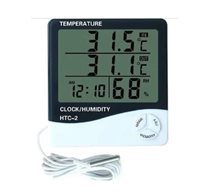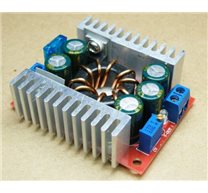TCS3200 Color Sensor is a complete color detectorincluding a TAOS TCS3200 RGB sensor chip and 4 white LEDs. The TCS3200 can detect and measure a nearly limitless range of visible colors. Applications include test strip readingsorting by colorambient light sensing and calibrationand color matchingto name just a few.
The TCS3200 has an array of photodetectorseach with either a redgreenor blue filteror no filter (clear). The filters of each color are distributed evenly throughout the array to eliminate location bias among the colors. Internal to the device is an oscillator which produces a square-wave output whose frequency is proportional to the intensity of the chosen color.
COLOR SENSOR (TCS230)
مقالتنا اليوم ستكون عن كيفية استشعار بعض الألوان وتمييزها باستخدام حساس الألوان واضاءة RGB LED وفقا للون المستشعر , وطباعة النتائج على الشاشة
فحساس الالون هو حساس يستطيع التمييز بين الالوان المختلفة , فان هذا الحساس يستطيع ان يحول شده الالوان الى ترددات (frequencies) مختلفة تعبر عن شده و نوعية اللون
لهذا الحساس ثمانية منافذ موضحة بالصورة :
سنقوم الان بشرح مختصر عن المنافذ :
Vcc & GND : فهذه لمصدر التغذية
S0,S1 : فهذه المنافذ لنتحكم ب دقه حساب الترددات المناسبة للالوان التي سنتحسسها
S2,S3 : و ايضا لتحديد نوعية الالوان
OE (output enable): للسماح باخد قيم التي ستنتج من الحساس ام لا
OUT : مخرج لنأخذ منه قيم الترددات للون الذي سنتحسسه
القطع التي نحتاجها في هذه التجربة :
1. بطاقة اردوينو UNO2. حساس ألالوان3. ثلاثي الألوان RGB4. ثلاث مقاومات 300 اوم5. اسلاك توصيل 6. Bread board
هذا الحساس يفتقر الى الدقه في الاستشعار ..... حيث انه مصمم لاستشعار 3 الوان و هم الاخضر , الازرق,الاحمر اما باقي الالوان لتحديدها , نحتاج لدارسة الترددات المنبعثة منها و تحديد طريقة استشعار مثل هذه الالوان. المميز بهذا الحساس انه لا يحتاج الى الكثير من الطاقه لتشغيله (low power consumption)
والان بعدما تعرفنا على منافذ الحساس و وصف موجز لطريقة عمله سنتعلم الان طريقة توصيل هذه القطعه .
التوصيل:
بعد ان تعرفنا على طريقة توصيل الحساس , الان سنتعرف على البرنامج الذي سنستخدمه في تجربتنا
البرنامج :
في النهاية سنريكم مجموعة من التجارب على الوان استطاع برنامجنا استشعارها :
#include <TimerOne.h>
#define S0 6 // Please notice the Pin's define
#define S1 5
#define S2 4
#define S3 3
#define OUT 2
int g_count = 0; // count the frequecy
int g_array[3]; // store the RGB value
int g_flag = 0; // filter of RGB queue
float g_SF[3]; // save the RGB Scale factor
// Init TSC230 and setting Frequency.
void TSC_Init()
{
pinMode(S0OUTPUT);
pinMode(S1OUTPUT);
pinMode(S2OUTPUT);
pinMode(S3OUTPUT);
pinMode(OUTINPUT);
digitalWrite(S0LOW); // OUTPUT FREQUENCY SCALING 2%
digitalWrite(S1HIGH);
}
// Select the filter color
void TSC_FilterColor(int Level01int Level02)
{
if (Level01 != 0)
Level01 = HIGH;
if (Level02 != 0)
Level02 = HIGH;
digitalWrite(S2Level01);
digitalWrite(S3Level02);
}
void TSC_Count()
{
g_count ++ ;
}
void TSC_Callback()
{
switch (g_flag)
{
case 0:
Serial.println("->WB Start");
TSC_WB(LOWLOW); //Filter without Red
break;
case 1:
Serial.print("->Frequency R=");
Serial.println(g_count);
g_array[0] = g_count;
TSC_WB(HIGHHIGH); //Filter without Green
break;
case 2:
Serial.print("->Frequency G=");
Serial.println(g_count);
g_array[1] = g_count;
TSC_WB(LOWHIGH); //Filter without Blue
break;
case 3:
Serial.print("->Frequency B=");
Serial.println(g_count);
Serial.println("->WB End");
g_array[2] = g_count;
TSC_WB(HIGHLOW); //Clear(no filter)
break;
default:
g_count = 0;
break;
}
}
void TSC_WB(int Level0int Level1) //White Balance
{
g_count = 0;
g_flag ++;
TSC_FilterColor(Level0Level1);
Timer1.setPeriod(1000000); // set 1s period
}
void setup()
{
TSC_Init();
Serial.begin(9600);
Timer1.initialize(); // defaulte is 1s
Timer1.attachInterrupt(TSC_Callback);
attachInterrupt(0TSC_CountRISING);
delay(4000);
for (int i = 0; i < 3; i++)
Serial.println(g_array);
g_SF[0] = 255.0 / g_array[0]; //R Scale factor
g_SF[1] = 255.0 / g_array[1] ; //G Scale factor
g_SF[2] = 255.0 / g_array[2] ; //B Scale factor
Serial.println(g_SF[0]);
Serial.println(g_SF[1]);
Serial.println(g_SF[2]);
}
void loop()
{
g_flag = 0;
for (int i = 0; i < 3; i++)
Serial.println(int(g_array * g_SF));
delay(4000);
}

